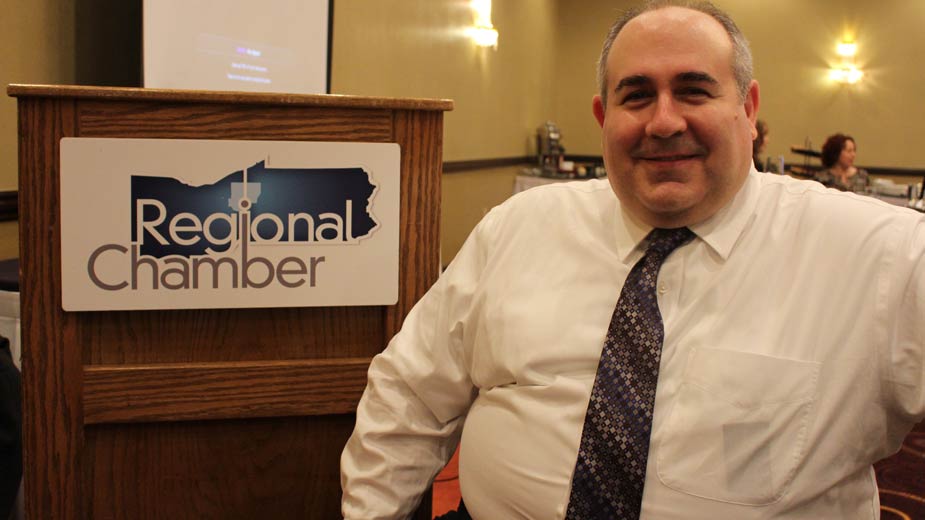Consultant Advises Public Speakers to Start at the End
BOARDMAN, Ohio – Speakers tend to concentrate too much on the information they are presenting. They should instead focus on how they want their listeners to feel — or the outcome they want to achieve, a consultant told business professionals Wednesday.
Individuals operate on several “fundamentally invalid” assumptions when it comes to public speaking, said Jonathan Altfeld, trainer and coach with Florida-based Mastery InSight Institute.
Altfeld was the featured speaker at the Youngstown Warren Regional Chamber’s Leadership Series: Speaking Wizardry breakfast. About 50 attended the one-hour training session at the Holiday Inn Boardman.
Many people come to public speaking with “incorrect preconceived notions about their own limitations and about what’s most important in speaking,” Altfeld said.
Among them is that what they say, or the exact wording, is “more important than how they make people feel,” he continued. While many strongly believe in rational reasoning, reasons are offered after the fact to justify their decisions.
“Every single choice we make as human beings is emotional, so teaching ourselves and others to become more emotionally intelligent about the choices we make gives us more empowering information,” he said. “As speakers, we have an outcome we would like people to achieve. We should start thinking about what we need them to feel toward the end of the talk.”
Understanding the importance of what people feel frees people to be more confident and comfortable when they address an audience, he added.
“How we make people feel from an audience perspective is what’s far more important,” Altfeld said, “which actually frees speakers up to be a lot more confident and comfortable on stage.”
He also advised his audience to design their speeches backward – that is, begin their drafts with the end in mind, namely the result that they want to achieve or what they want listeners to achieve.
“Your primary goal is to elicit that feeling. You don’t deliver your call to action until they feel that,” he said. “Design your speech backward from that ending emotion.”
In school, people learn to draft a presentation as an outline, which isn’t “the optimal way” to write a talk, he said. The speaker’s job is to move the audience from where they are to where he wants to take them, to elicit the desired response, such as a call to action.
Other misconceptions many speakers have is that their audiences expect “near perfection or better,” that they shouldn’t use “natural filler” such as “umm” or “ahh,” or that the game is over such they make a big mistake and try to recover.
“People love to see you recover gracefully,” Altfeld said. Also, while keynote speeches and certain sales presentations require “massive amounts of preparation and practice,” most speeches don’t, he said.
He advised against providing a topic sentence or summary at the outset, a device that allows an audience to judge the speaker from the start.
“Tap into the why. Touch on people’s deep-seated values. Trigger curiosity first,” he advised. “I won’t start teaching content until I see faces showing curiosity. Why would I talk until I’m blue in the face about information you’re not curious about? It’s wasting your time and mine.”
Among those at the breakfast program was Danielle Jackson, client services representative at Executive Computer Management Solutions Inc., Struthers. She wanted to learn how to improve her communications with her employees, many of whom she needs to reach via email.
“The first thing you do when you write an email is think about how you would say it to a person,” Jackson said. “So while this was more of an audience speaking event, there were some definite, interesting takeaways as far as eliciting the emotion and wanting to make sure that the audience comes with you.”
Pictured: Jonathan Altfeld, trainer and coach with Mastery InSight Institute.
Copyright 2024 The Business Journal, Youngstown, Ohio.



